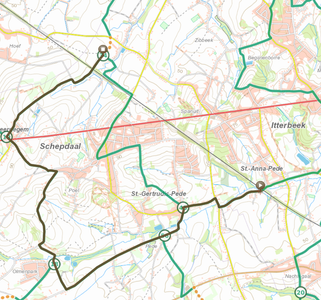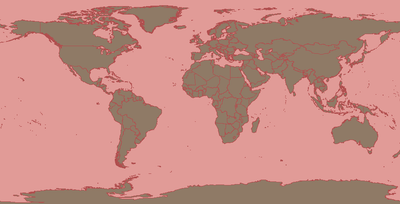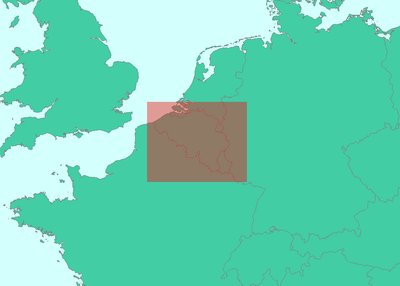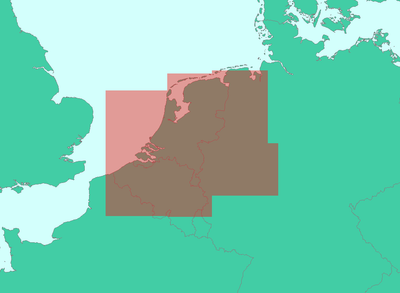Optionen für die Routenführung
Inhaltsangabe
- Was bewirken die Routing-Optionen?
- An overview of the routing options
- Beziehung zwischen Routing-Optionen und Untergrund
- In welchen Regionen gibt es welche Routing-Optionen?
- Einstellung der Routing-Option
- Häufig gestellte Fragen
- Die Routing folgt nicht dem von mir gewünschten Weg.
- Gibt es einen Unterschied zwischen der Routing-Option 'Rennrad - am schönsten' und 'Freizeitradeln (nur befestigt) - am schönsten'?
- Ich erhalte die Meldung 'Die ausgewählten Punkte liegen zu weit auseinander'. Warum bekomme ich diese Meldung?
- Ich kann bestimmte Routing-Optionen im RoutePlanner nicht sehen. Woran liegt das?
- „Das System leitet mich trotzdem über unbefestigte Straßen.“
Was bewirken die Routing-Optionen?
Wenn Sie Viapunkte im RoutePlanner anklicken, wird eine Route zwischen diesen Viapunkten mit einer bestimmten Routingmethode berechnet. Die klassischsten Routingmethoden sind der kürzeste und der schnellste Weg. Eine weitere interessante Option in der Freizeitwelt ist die schönste Route. Lesen Sie hier, wie wir das bei RouteYou ermitteln.
Wie das Routing erfolgt, hängt auch davon ab, wie die Reise durchgeführt wird: zu Fuß, mit dem Fahrrad, mit dem Mountainbike, zu Pferd, mit dem Motorrad und so weiter. Deshalb bietet RouteYou zahlreiche Optionen, die eine bestimmte Art der Fortbewegung (zu Fuß, mit dem Fahrrad, ...) und die gewünschte Routingmethode miteinander verbinden: die kürzeste, die schnellste oder die schönste.
An overview of the routing options
- Wandern - am schönsten: wir bieten Ihnen eine Route entlang der schönsten Wanderwege.
- Wandern - kürzeste: wir bieten Ihnen die kürzeste Route entlang der für Wanderer zugänglichen Wege an.
- Wandern - Knotenpunkte: Sie erhalten eine Route, die ausschließlich entlang des Wanderknotenpunktnetzes verläuft.
- Freizeitradeln - am schönsten: Wir schicken Sie auf den schönsten Radwegen, darunter auch unbefestigte Wege in gutem Zustand. Diese Option ist also nicht so sehr für Rennradfahrer geeignet (lesen Sie hier mehr), aber sehr gut für Freizeitradler, die sich auf schönen Wegen und ungeahnten, meist ruhigen Straßen überraschen lassen wollen.
- Freizeitradeln - kürzeste: Die kürzeste Strecke, die Sie als Radfahrer fahren können, auch auf unbefestigten Wegen (über unser bekanntes Netz).
- Freizeitradeln - am schönsten (nur befestigt): Wir schicken Sie entlang der schönsten asphaltierten Radwege. Diese Option vermeidet unbefestigte Straßen, unabhängig von deren Zustand.
- Freizeitradeln - kürzeste (nur befestigt): Wir bieten Ihnen die kürzeste Route über asphaltierte, für Radfahrer zugängliche Wege.
- Knotenpunktfahren: Ihnen wird eine Route angeboten, die ausschließlich über das Radknotenpunktnetz führt. Ihre Route kann auch unbefestigte Abschnitte enthalten.
- Knotenpunktfahren (nur befestigt): Sie erhalten eine Route, die nur über die asphaltierten Teile des Fahrradknotenpunktnetzes führt.
- Knotenpunktfahren (Steigungen vermeiden): Sie erhalten eine Route, die ausschließlich über das Fahrradknotenpunktnetz führt und so viele Steigungen wie möglich vermeidet.
- Rennrad - am schönsten: Wir schicken Sie auf die schönsten Radrouten, die besonders für Rennräder geeignet sind.
- Rennrad - kürzeste: Sie bekommen die kürzeste rennradtaugliche Strecke angeboten.
- Rennrad - am schönsten (Kopfseinpflaster vermeiden): Wir schicken Sie auf die schönsten Radrouten, die besonders für Rennradfahrer geeignet sind, aber Kopfsteinpflaster vermeiden.
- Rennrad - kürzeste (Kopfseinpflaster vermeiden): Wir bieten Ihnen die kürzeste Route an, die für Rennradfahrer geeignet ist, aber Kopfsteinpflaster vermeidet.
- Rennrad mit Begeleifahrzeug - am schönsten: Wir schicken Sie auf die schönsten Radstrecken, die sich besonders für eine Gruppe von Rennradfahrern in Begleitung eines Begleitfahrzeugs eignen.
- Rennrad mit Begeleifahrzeug - kürzeste: Wir bieten Ihnen die kürzeste Route an, die für Rennradfahrer in Begleitung eines Begleitfahrzeugs geeignet ist.
- Mountainbike - am schönsten: Wir schicken Sie auf die schönsten Radstrecken, die besonders für Mountainbiker geeignet sind.
- Mountainbike - kürzeste: Wir bieten Ihnen die kürzeste Route, die für Mountainbiker geeignet ist.
- MTB Sport Vlaanderen: Wir schicken Sie auf die von Sport Vlaanderen ausgearbeiteten und ausgeschilderten Mountainbike-Routen.
- MTB Sport Vlaanderen (all Richtungen): Wir schicken Sie auf den von Sport Vlaanderen ausgearbeiteten und ausgeschilderten Mountainbikerouten. Und zwar sowohl in der angegebenen Richtung als auch in der Gegenrichtung.
- Gravel-bike - am schönsten (Winter): Wir schicken Sie auf die schönsten Radwege, die für Gravelbiker besonders geeignet und im Winter ausreichend befahrbar sind. Der Schwerpunkt liegt auf "unbefestigten Wegen in gutem Zustand".
- Gravel-bike - kürzeste (Winter): Es wird Ihnen der kürzeste Weg angeboten, der für Gravelbiker geeignet und im Winter ausreichend befahrbar ist. Der Schwerpunkt liegt auf "unbefestigten Wegen in gutem Zustand".
- Gravel-bike - am schönsten (Sommer): Wir schicken Sie auf die schönsten Radwege, die für Gravelbiker besonders geeignet sind. Sommertaugliche Routen führen auch über unbefestigte Wege, die bei winterlichen Verhältnissen oft kaum befahrbar sind: "unbefestigte Wege in schlechtem Zustand".
- Gravel-bike - kürzeste (Sommer): Es wird Ihnen die kürzeste für Gravelbiker geeignete Strecke angeboten. Sommertaugliche Routen führen auch über unbefestigte Wege, die bei winterlichen Verhältnissen oft kaum befahrbar sind: "unbefestigte Wege in schlechtem Zustand".
- Motorrad - am schönsten: Wir schicken Sie auf die schönsten Wege, die besonders für motorisierte Fahrzeuge wie Motorräder und Autos geeignet sind.
- Motorrad - kürzeste: Wir bieten Ihnen die kürzeste Route, die für motorisierte Fahrzeuge wie Motorräder und Autos geeignet ist.
- Motorrad - am schnellsten: Wir schicken Sie auf Straßen, auf denen Sie mit motorisierten Fahrzeugen wie Motorräder und Autos am problemlosesten durchkommen und bieten Ihnen somit die schnellste Route.
- Pferdeknoten-Netzwerk: Sie erhalten eine Route, die ausschließlich über das Pferdeknoten-Netzwerk führt.
- Inline skating - am schönsten: Wir schicken Sie über die schönsten asphaltierten Straßen (ohne Kopfsteinpflaster), die für Inline-Skater besonders geeignet sind.
- Inline skating - kürzeste: Wir bieten Ihnen die kürzeste Route entlang befestigter Straßen (ohne Kopfsteinpflaster), die für Inline-Skater geeignet sind.
- Kürzeste - OSM: Es wird Ihnen die kürzeste verfügbare Route entlang der in OpenStreetmap bekannten Wege angeboten. Dabei werden keine Einschränkungen oder Eigenschaften dieser Wege berücksichtigt.
- Manuell: Manchmal möchte man eine Strecke unabhängig von einer zugrunde liegenden Karte planen. Dann nutzen Sie nicht die Routenführung, sondern zeichnen Ihre Strecke von Punkt zu Punkt (mehr dazu hier).
Achtung (!) Nicht alle Routing-Optionen sind in jedem Land verfügbar.
Hintergrundinformationen zu einigen Routing-Optionen
Jede Straße ist individuell nach ihrer Eignung für Radfahrer, Wanderer, Motorradfahrer, ... klassifiziert. Auf diese Weise kann die kürzeste und schnellste, aber auch die schönste Route ausgewählt werden.
Die schönste Route
Neben der schnellsten und kürzesten Route bieten wir auch einen fortschrittlichen Routing-Algorithmus, der auf mehr als 38 Parametern basiert, um eine "schönste" Route zwischen zwei Punkten zu berechnen. Diese "schönste" Route hängt von der von Ihnen gewählten Art der Fortbewegung ab: Wandern, Rennradfahren, Mountainbiking, Motorradfahren, ... . Über "am besten geeignet" und "am schönsten" kann man viel diskutieren. Uns ist klar, dass dies mehr Kunst als Wissenschaft ist. Dennoch sind wir nach unseren Recherchen zu dem Schluss gekommen, dass professionell entworfene Routen dazu neigen, bestimmten Eigenschaften von Straßen zu folgen und andere Eigenschaften zu vermeiden. Mehr als 85 % davon konnten wir mit unserem ständig wachsenden Satz von mehr als 38 Parametern in Verbindung bringen: z. B. Straßenbreite, Bedeutung der Straße, Überfüllung der Straße, durch oder entlang von Waldgebieten, entlang von Flüssen, in der Nähe von Seen, in der Nähe von oder durch Parks, bebaute Gebiete, Industriegebiete und so weiter. Wir hoffen, dass diese Informationen für Sie nützlich sind und Ihnen helfen, eine geeignete Route schneller zu planen.
Sollten Sie mit unserer Berechnung der "Eignung" nicht einverstanden sein, können Sie die Route jederzeit anpassen. Schließlich gilt: "Des goûts et des couleurs on ne discute pas".
Rennrad mit Begleitfahrzeug
Es wird eine Routenoption für Rennradfahrer mit Begleitfahrzeug (schönste & kürzeste) angeboten. Sie finden diese Option unter dem Routentyp 'Rennradroute'.
Diese Routing-Option unterscheidet sich von den regulären Rennrad-Routen (schönste oder kürzeste), da diese Optionen autofreie Straßen bevorzugen. Das ist natürlich nicht so praktisch, wenn Sie mit einem Begleitfahrzeug hinter den Radfahrern bleiben müssen. Sie könnten auch " Motorrad - am schönsten" wählen, aber das könnte Sie über Strecken führen, die Sie mit dem Auto oder dem Motorrad passieren dürfen, aber nicht mit dem Fahrrad. Daher diese separate Routing-Option.
Knotenpunktfahren - Steigungen vermeiden
Die Routing-Option " Knotenpunktfahren - Steigungen vermeiden" ermöglicht es Ihnen, so viele steile Steigungen wie möglich zu vermeiden. Wichtig ist hier der Ansatz "so viel wie möglich". Schließlich bedeutet das nicht, dass Sie nicht mehr "bergauf" kommen. Wenn Sie einen Berg oder Hügel überqueren müssen, müssen Sie natürlich auf die eine oder andere Weise hinaufgehen. Aber diese Option lenkt Sie entlang der am wenigsten steilen Seite. Wir berücksichtigen auch die Richtung des Gefälles. Steil bergab wird nicht bestraft. Steil bergauf schon. Es kann also durchaus sein, dass Sie auf dem Hin- und Rückweg eine andere Option haben.

Hier ist ein schönes Beispiel für die Auswirkungen dieser Routing. Wenn Sie vom Süden von Schepdaal in den Norden von Schepdaal (in der belgischen Region Pajottenland) radeln möchten, müssen Sie den steilen Bergrücken hinauffahren, über den der Ninoofsesteenweg (rote Linie) verläuft. Wie Sie sehen können, gibt es zwei Abzweigungsrouten. Eine über Sint-Getrudis-Pede mit einem mehr als munteren Wadenbeißer und eine über den westlichen Teil von Schepdaal, wo es auch Steigungen gibt, aber etwas weniger steil. Sie erhalten also eine etwas längere Variante, aber weniger steile Steigungen.
Kürzeste - OSM
Kürzeste OSM steht für "die kürzeste Route entlang der in OpenStreetmapbekannten Wege".
Mit dieser Option zeichnen wir die kürzeste Route entlang der in der OpenStreetMap-Karte bekannten Straßen und Wege. ACHTUNG! Das bedeutet, dass wir nicht berücksichtigen, ob es erlaubt ist oder nicht (z.B. Einbahnstraßen, unbefestigte Straßen, Autobahnen,...). Wenn Sie diese Funktion nutzen, sollten Sie sich in der Gegend gut auskennen!
TIPP: Für Benutzer, die eine bekannte Route aus einer Karte neu zeichnen wollen, ist die Option Kürzeste OSM eine sehr geeignete Lösung.
Wenn Sie z.B. die Option 'Freizeitradeln - am schönsten' verwenden, schicken wir Sie manchmal über Abschnitte, die wir für besser zum Radfahren halten. Und das kann verwirrend sein, wenn Sie genau wissen, wie Ihre Route verlaufen soll.
Beziehung zwischen Routing-Optionen und Untergrund
Bei den Routing-Optionen sind viele Aspekte zu berücksichtigen, aber ein sehr wichtiges Element ist der Untergrund.
In Bezug auf den Untergrund unterscheiden wir 4 Kategorien:
- Befestigt
- Befestigt - glatt: z. B. Asphalt, Ziegelsteine, Betonplatten...
- Befestigt - rau: z. B. Kopfsteinpflaster, schlecht gepflegter Asphalt mit tiefen Schlaglöchern, usw.
- Unbefestigt
- Unbefestigt - glatt: z. B. Schotter, vegetationsfreier Boden, aber gut befahrbar
- Unbefestigt - rau: z. B. Schotter mit vielen Gruben, vegetationsfreier Boden mit vielen Unebenheiten, Abschnitte mit viel Vegetation
In der folgenden Matrix können Sie sehen, welche Abschnitte
- pro Routing erlaubt sind
- für jedes Routing bevorzugt werden
- pro Routing nicht erlaubt sind
| Befestigt - glatt | Befestigt - rau | Unbefestigt - glatt | Unbefestigt - rau | |
|---|---|---|---|---|
| Rennrad (schönste und kurzeste) | BEVORZUGT | ERLAUBT | ||
| Freizeitrad (schönstes und kürzestes) | BEVORZUGT | ERLAUBT | BEVORZUGT | |
| MTB | ERLAUBT | ERLAUBT | BEVORZUGT | BEVORZUGT |
| Wandern | ERLAUBT | ERLAUBT | BEVORZUGT | BEVORZUGT |
Ein Beispiel zur Veranschaulichung, wie die Tabelle zu lesen ist:
- Wenn Sie sich für die Routen-Option "Freizeitradeln - am schönsten" entscheiden, dann können Sie unter VORZUG eine befestigte ('glatte') Untergrund oder eine unbefestigte ('glatte') Untergrund wie Schotter erwarten. Sie können auch auf Abschnitte mit rauem Asphalt stoßen, aber diese sind eher die Ausnahme. Sie sollten davon ausgehen, dass Sie KEINE Abschnitte mit rauem, unbefestigtem Untergrund finden werden.
Hinweis! Dies ist nur einer von vielen Parametern, die in den Routing-Optionen verwendet werden. Lesen Sie zum Beispiel hier mehr über das schönste Routing.
In welchen Regionen gibt es welche Routing-Optionen?
|
Routenführung |
Gebiet |
|
Freizeitradeln - am schönsten, kürzeste |
|
|
Freizeitradeln - am schönsten – nur befestigt Rennrad mit Begleitfahrzeug - am schönsten
|
|
|
Rennrad - kürzeste - Aufstiege vermeiden |
|
|
Freizeitradeln – Knotenpunkte |
|
Einstellung der Routing-Option
Im Routenplaner finden Sie im Modul Plan die Option "Routing". Hier können Sie die gewünschte Routing-Option auswählen. Die Liste ist lang, aber je nach Ihrer Auswahl im Abschnitt "Routing-Typ" verkürzt sich die verfügbare Liste. Es werden nur die Routing-Optionen angezeigt, die für den gewählten Routing-Typ geeignet sind.
Wenn Sie einen Viapunkt hinzufügen oder verschieben, werden Sie die Auswirkungen sehen. Die Route wird entsprechend der gewählten Routing-Option (neu) berechnet.
Was passiert, wenn Sie das Routing ändern?
Wenn Sie während oder nach dem Planen einer Route das Routing ändern, werden Sie gefragt, ob Sie das neue Routing anwenden möchten auf:
- die komplette Route
- die nächsten Änderungen
Auf die komplette Route anwenden
>> In diesem Fall wird die komplette Route entsprechend der neuen Routing neu errechnet.
Angenommen, Sie haben bereits eine Route von A nach B nach C nach D erstellt. Wenn Sie die erste Option wählen, bei der die neue Routing auf die gesamte Route angewendet wird, wird jeder Abschnitt der bereits erstellten Route (A-B, B-C, C-D) entsprechend der neu gewählten Routing neu berechnet.
Auf nachstehende Änderungen anwenden
>> Nur der Routenabschnitt, den Sie noch planen oder ändern werden, wird entsprechend der neuen Routing (neu) berechnet.
Angenommen, Sie hatten bereits eine Route von A nach B nach C nach D geplant und wählen die zweite Option, bei der die neue Routing nur auf die nächsten Änderungen angewendet wird. Je nachdem, was Sie tun, kann dies unterschiedliche Auswirkungen haben:
Die Optionen:
- Fügen Sie einen zusätzlichen Punkt am Ende Ihrer Route hinzu: Wenn Sie einen zusätzlichen Punkt E zu Ihrer Route hinzufügen, wird nur die Route D-E nach der neuen Routing berechnet. Die Strecken A-B, B-C, C-D bleiben unverändert.
- Hinzufügen eines zusätzlichen Punktes zwischen zwei bestehenden Punkten: Klicken Sie zwischen den Punkten B und C auf die Route und ziehen Sie diesen Punkt an eine bestimmte Stelle. Nennen wir diesen Punkt P. Dann werden die Bahnen B-P und P-C entsprechend der neu festgelegten Routing neu berechnet. Die Trajektorien A-B, C-D bleiben unverändert.
- Verschieben eines bestehenden Punktes: Ziehen Sie den Punkt C an eine neue Position, dann wird die Route B-C und C-D entsprechend der neu festgelegten Routing neu berechnet. Die Route A-B bleibt unverändert.
Häufig gestellte Fragen
Die Routing folgt nicht dem von mir gewünschten Weg.
Wenn Sie über kleine (unbefestigte) Wege fahren möchten, wählen Sie am besten "kürzeste - OSM". Bitte beachten Sie, dass dabei Wegbeschränkungen wie Einbahnstraßen oder Wege mit Zugangsbeschränkungen etc. nicht berücksichtigt werden. Das System folgt dem verfügbaren Netz, unabhängig von den Modi, für die Sie planen.
Wenn Sie die volle Kontrolle über Ihre Routenplanung haben möchten und auch über Wege fahren möchten, die (noch) nicht im Netz enthalten sind, können Sie auch zur "manuellen" Routing wechseln..
Gibt es einen Unterschied zwischen der Routing-Option 'Rennrad - am schönsten' und 'Freizeitradeln (nur befestigt) - am schönsten'?
Es stimmt, dass sowohl die Routing-Option 'Rennrad - am schönsten' als auch die Routing-Option 'Freizeitradeln (nur befestigt) - am schönsten' Sie über befestigte Straßenabschnitte schicken. Aber was ist der Unterschied?
- Mit Rennrad - am schönsten führen wir Sie über nicht übermäßig schmale (befestigte) Wege. Bei Freizeitradeln (nur befestigt) - am schönsten beziehen wir auch schmalere Wege mit ein.
- Bei Rennrad – am schönsten achten wir darauf, dass Sie nicht zu oft links oder rechts abbiegen müssen, damit Sie nicht aus dem Tritt kommen. Dadurch fallen allerdings einige Abkürzungen weg. Bei Freizeitradeln (nur befestigt) - am schönsten ist der Trittrhythmus weniger wichtig, was zur Folge hat, dass Sie häufiger über schöne, aber kurze Streckenabschnitte geleitet werden.
- Bei Rennrad – am schönsten führen wir Sie eher über Radwege, die sich mit bestehenden Routen für die Kategorie Rennrad überlappen. Bei Freizeitradeln– am schönsten führen wir Sie eher über Radwege, die sich mit bestehenden Routen für die Kategorie Freizeitradler überlappen.
Ich erhalte die Meldung 'Die ausgewählten Punkte liegen zu weit auseinander'. Warum bekomme ich diese Meldung?
Bei einigen Routing-Optionen dauert es etwas länger, bis der schönste Weg berechnet ist. Deshalb begrenzen wir den Abstand zwischen zwei Viapunkten, um eine lange Wartezeit zu vermeiden. Sie können dieses Problem lösen, indem Sie einen zusätzlichen Viapunkt hinzufügen, um die Entfernung zwischen den Viapunkten auf maximal 300 km zu begrenzen.
Ich kann bestimmte Routing-Optionen im RoutePlanner nicht sehen. Woran liegt das?
- Option 1 - 'manuell fehlt': Vermutlich haben Sie bei der Planung die Option " Rundweg" gewählt. Bei der Planung einer Rundweg bieten wir die Option 'manuell' (oder 'kürzeste') nicht an, da sie immer eine Route über das Netzwerk berechnet. Die Option "manuell" ist nur dafür gedacht, nicht über das Netz zu fahren. Bei einer "Rundweg" ist das also ein Widerspruch.
Auch die Option 'kürzeste' ist hier nicht verfügbar, weil wir Ihnen nur eine Rundweg anbieten wollen. Die kürzeste Option wäre dann, einfach am Startpunkt zu bleiben.
>> LÖSUNG: Wenn Sie die Option "Von A nach B" im Planer auswählen, werden Sie sehen, dass Sie die Optionen "manuell" (oder "kürzeste") erhalten.
- Option 2 - 'Ich sehe keine Routingmöglichkeiten für Wanderungen': Die Routingoptionen, die Sie erhalten, hängen immer vom Routentyp ab. Wenn Sie z.B. den Typ "Fahrrad" auswählen, bieten wir keine Wanderrouten wie "Wandern - Knotenpunkte" an.
>> LÖSUNG: Wenn Sie den richtigen Routentyp auswählen, erhalten Sie die relevanten Optionen.
- Option 3: Nicht alle Regionen der Welt haben die gleichen Optionen in Bezug auf die Routing-Optionen. Bestimmte Routing-Optionen sind in bestimmten Regionen nicht relevant, weil es sie einfach nicht gibt. Ein Beispiel dafür ist "Wandern - Knotenpunkte" . Nicht überall auf der Welt gibt es bereits Walking-Node-Netze. Auch verfügen wir in "abgelegenen Gebieten" möglicherweise noch nicht über alle Daten, um Routing anzubieten.



